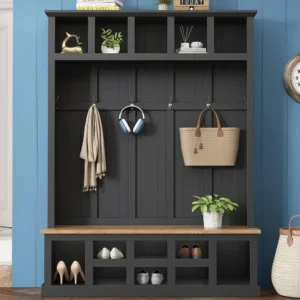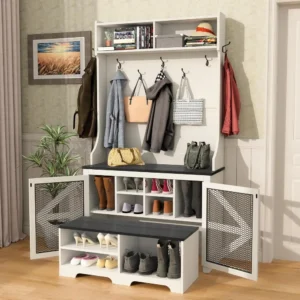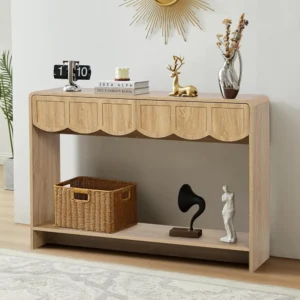Understanding the Entryway Challenge
Your entryway sets the first impression of your home, welcoming both you and your guests. Yet this crucial space often becomes a chaotic collection point for everyday items, creating stress and frustration. The entryway challenge is universal but particularly pressing in modern homes where space comes at a premium.
Common entryway problems include:
- Clutter accumulation from shoes, bags, and outerwear
- Limited square footage (the average home entryway is just 25-30 square feet)
- Lack of designated storage for everyday essentials
- Disorganization that leads to misplaced items
- Seasonal overflow from weather-related accessories
These challenges directly impact your daily life. The morning rush becomes more stressful when you can’t find your keys. Arriving home means navigating through scattered shoes and bags. Guests form impressions based on this often-overlooked space. The good news? Smart, space-saving benches for entryways can dramatically transform how you use and experience this vital area of your home.
Multi-functional furniture offers the perfect solution, providing practical storage while maintaining style. By addressing the entryway’s unique demands, these versatile pieces help create order from chaos without sacrificing your home’s aesthetic appeal.
What Makes Furniture Truly Multi-Functional for Entryways?
Multi-functional entryway furniture strikes the perfect balance between practicality and design, solving multiple problems with a single piece. Unlike single-purpose items that serve just one need, these versatile solutions maximize every inch of your space while enhancing your home’s aesthetic.
Key characteristics of quality multi-functional entryway furniture include:
- Space optimization that works in compact areas
- Dual or triple functionality (seating + storage + display)
- Durable materials that withstand high traffic and daily use
- Hidden compartments that conceal everyday clutter
- Adaptable designs that work with various home styles
- Thoughtful organization features for specific items (shoes, keys, mail)
The difference between ordinary and multi-functional furniture becomes clear when comparing a basic bench to a storage bench. The simple bench provides seating only, while the storage version offers the same seating plus organized space for shoes, bags, or seasonal items—effectively doubling its value to your home.
Quality materials matter tremendously in entryway furniture. Look for solid wood construction, reinforced joints, and water-resistant finishes that can handle wet umbrellas and snowy boots. These investment pieces should withstand years of daily use while maintaining their appearance, making them worth the initial cost. For small spaces, specially designed pieces help optimize small entryway areas with bench furniture without sacrificing functionality.
Essential Multi-Functional Entryway Benches: Sit, Store, and Style
Entryway benches represent perhaps the most versatile solution for entryway organization, serving multiple essential purposes in a single footprint. Their primary advantage is obvious—a comfortable place to sit while putting on or removing shoes—but today’s designs go far beyond this basic function.
Modern storage benches come in several configurations, each addressing specific needs:
Cubbied bench designs feature open compartments beneath the seating surface, perfect for frequently used shoes that need to breathe. These accessible cubbies typically accommodate 6-8 pairs of adult shoes while allowing quick visual identification.
Lift-top storage benches offer concealed storage under a hinged seat, ideal for seasonal items, extra linens, or clutter you want hidden from view. The seamless appearance maintains a clean aesthetic while maximizing storage capacity.
Drawer benches incorporate pull-out storage beneath the seating area, perfect for small items like hats, gloves, sunglasses, or dog-walking supplies. Drawers provide organized access without requiring you to remove items stacked on top.
Hybrid designs combine seating with vertical storage elements like attached coat racks, hook systems, or small shelves—effectively creating a compact hall tree in a smaller footprint.
The beauty of today’s entryway benches with integrated storage solutions lies in their design versatility. Whether your home embraces farmhouse charm, mid-century modern lines, or industrial elements, you’ll find bench options that complement your aesthetic while solving practical challenges.
Space-Saving Console Tables: Slim Profiles with Maximum Utility
For entryways where floor space is limited but organization is essential, console tables provide an elegant solution with their characteristically narrow profiles. These slim workhorses typically extend just 10-15 inches from the wall while offering substantial utility for everyday items.
The best entryway console tables incorporate multiple functional elements:
- Shallow drawers for mail, keys, sunglasses, and small accessories
- Lower shelves for shoes, bags, or decorative baskets
- Hidden compartments that keep clutter out of sight
- Durable top surfaces that withstand daily use as a “drop zone”
What makes consoles particularly valuable is their placement flexibility. While traditionally positioned against walls, they also work beautifully behind sofas in open-concept homes or as room dividers to create the impression of a dedicated entryway where none exists architecturally.
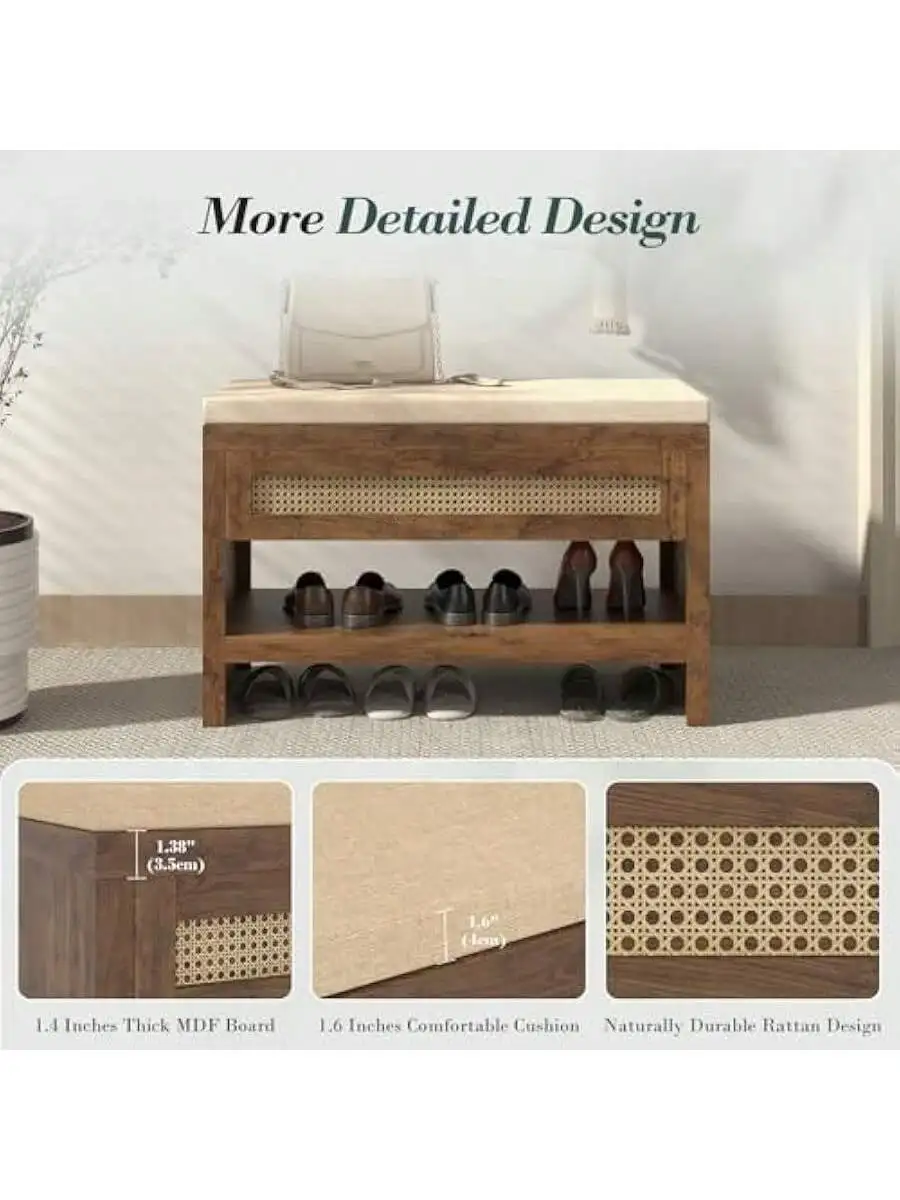
The key to maximizing console functionality lies in thoughtful styling. Incorporate decorative trays to corral small items, add hooks underneath for hanging storage, and consider height-appropriate baskets for the lower shelf. For truly compact spaces, narrow bench options for space-constrained entryways can provide similar functionality with integrated seating in a slim profile.
When selecting a console, pay particular attention to depth measurements, as even an inch or two can make a significant difference in tight hallways or areas where doors need clearance to swing freely.
All-In-One Hall Trees: The Complete Entryway Solution
When space allows, hall trees offer the most comprehensive entryway solution, combining multiple furniture pieces into one cohesive unit. These all-in-one centers address virtually every entryway need simultaneously, creating an organized command center for coming and going.
Modern hall trees typically feature combinations of:
- Bench seating for comfortable shoe changes
- Lower storage compartments for footwear and bags
- Multiple hooks or hanging areas for coats, bags, and accessories
- Upper shelving for seasonal items or decorative elements
- Optional mirror integration for last-minute appearance checks
- Back panels that prevent wall contact from coats and bags
Comprehensive hall tree solutions come in various configurations to suit different spaces and needs. Corner models maximize awkward areas, while slim-profile designs work in narrower hallways without sacrificing functionality. The storage capacity is impressive—a standard hall tree can organize 4-8 coats, 6-10 pairs of shoes, plus accessories, effectively replacing multiple separate furniture pieces.
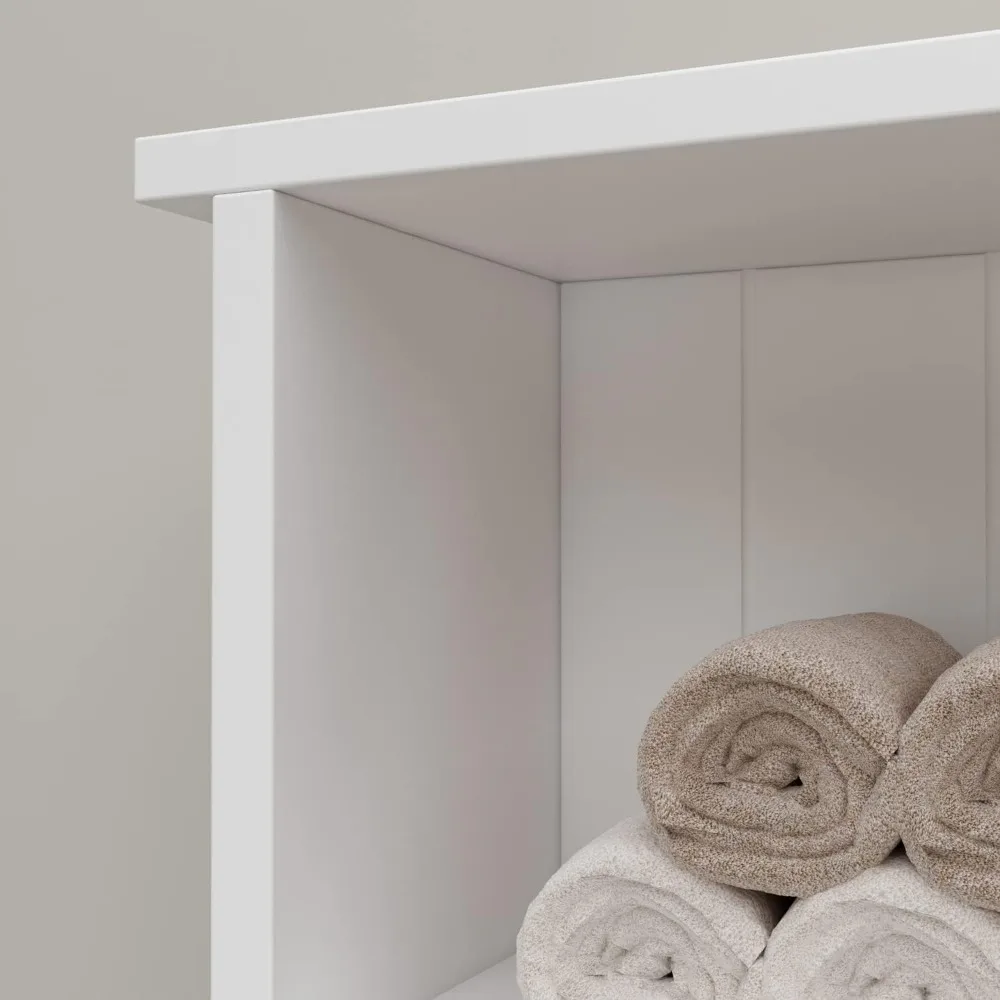
Design approaches range from traditional wooden hall trees reminiscent of vintage coat stands to contemporary models with clean lines and mixed materials. The investment typically pays off through significant space optimization and the convenience of having every entryway essential organized in one location.
Maximizing Vertical Space: Wall-Mounted Entryway Solutions
When floor space is at an absolute premium, looking upward becomes essential. Wall-mounted entryway solutions utilize vertical real estate that often goes overlooked, creating functional storage without consuming precious square footage.
Effective wall-mounted options include:
- Floating shelves with integrated hook systems underneath
- Wall cabinets with drop-down fronts that create temporary surfaces
- Modular panel systems with customizable components
- Fold-down desks or tables that appear only when needed
- Magnetic or cork organizational panels for mail and notes
These vertical solutions are particularly valuable in apartments, small homes, or entryways with unusual configurations. By keeping the floor clear, they maintain an open, spacious feeling while still providing essential organization.
Weight capacity becomes an important consideration with wall-mounted furniture. Look for systems that specify their load limits and include proper mounting hardware. Many options can support 30-50 pounds per linear foot when properly installed into wall studs.
For renters or those hesitant about permanent installations, removable options like over-the-door organizers, tension rod systems, or command-hook arrangements can provide similar benefits without wall damage. Creative space-saving ideas for limited entryway areas often combine these temporary solutions with small-footprint furniture for comprehensive organization.
Concealed Storage Champions: Cabinets & Chests for Entryways
For those who prefer a clean, clutter-free appearance, entryway cabinets and chests offer the ultimate in disguised storage. These pieces conceal everyday items behind doors and drawers, presenting a polished exterior while hiding the organizational systems within.
Specialized entryway cabinets include:
- Slim shoe cabinets (sometimes called shoe dressers) that hold 9-20 pairs in a depth of just 6-8 inches
- Entryway armoires that conceal coats, bags, and accessories behind full-length doors
- Repurposed dressers with drawers reconfigured for entryway essentials
- Credenzas and sideboards adapted for entryway use with internal organizers
The primary advantage of these pieces is their ability to make clutter invisible, maintaining a serene first impression. Rather than seeing a collection of shoes, visitors see only an attractive piece of furniture.
When selecting concealed storage, depth measurements become particularly important. Traditional cabinets often extend 16-24 inches from the wall—too deep for many entryways. Look specifically for slim-profile or entryway-designed cabinets with depths of 10-14 inches that won’t impede traffic flow.
Specialized benches for storing shoes in entryways often represent the perfect compromise, offering both concealed storage and seating functionality in a single piece, maximizing value in limited space.
Shoe Storage Bench for Entryway
$459.02 Select options This product has multiple variants. The options may be chosen on the product pageBench with Hooks and Storage, Entryway Hall Tree, Mudroom Bench with Cubbies, Mudroom Bench with Shoe Storage
$818.38 Select options This product has multiple variants. The options may be chosen on the product pageEntryway Coat Rack Bench, Entryway Hall Tree, Farmhouse Mudroom Bench, Mudroom Bench with Shoe Storage
$805.09 Select options This product has multiple variants. The options may be chosen on the product pageBench with Hooks and Storage, Entryway Coat Rack Bench, Entryway Hall Tree, Mudroom Bench with Shoe Storage, Mudroom Coat Rack Bench
$793.73 Select options This product has multiple variants. The options may be chosen on the product page- Price range: $785.40 through $897.63 Select options This product has multiple variants. The options may be chosen on the product page
Coat Rack Shoe Bench, Entryway Coat Rack Bench, Entryway Hall Tree, Wood Entryway Bench
$479.82 Select options This product has multiple variants. The options may be chosen on the product page
Creative & Innovative Entryway Solutions
Looking beyond conventional entryway furniture reveals unexpected solutions that can address your organization needs with style and innovation. These creative approaches often repurpose items not typically associated with entryways, delivering fresh functionality and unique aesthetic appeal.
Multi-purpose ottomans and poufs offer perhaps the most versatile option. These compact pieces provide:
* Comfortable, movable seating
* Hidden storage under lift-tops
* Flexible placement that adapts to changing needs
* Lower profiles that don’t overwhelm small spaces
Nesting tables represent another innovative solution, providing expandable surface area that can be condensed when not needed. Use the smaller table daily for keys and mail, then pull out the larger table when additional surface area is required.
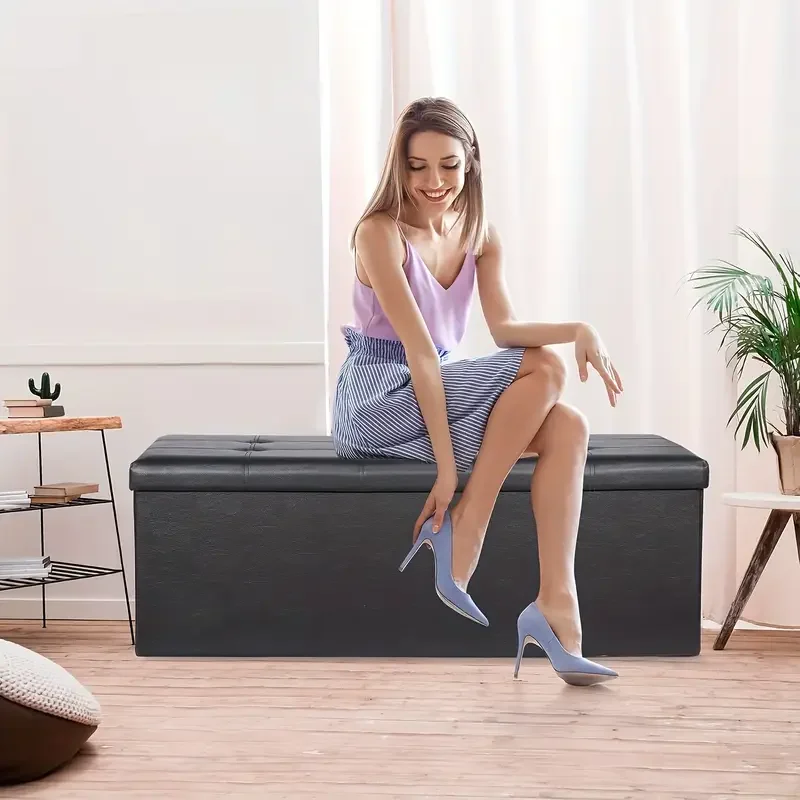
Repurposed items offer both sustainability and unique character:
* Vintage ladders as vertical coat and scarf displays
* Wooden crates stacked and secured as modular storage
* Old dressers reimagined with basket inserts and hooks
* Antique trunks that provide both storage and seating
These creative solutions often cost less than purpose-built entryway furniture while offering distinctive charm. For challenging spaces like narrow corridors, specialized solutions designed for narrow hallway spaces provide inspiration that balances form and function.
How to Choose the Perfect Multi-Functional Piece for Your Space
Selecting the right multi-functional entryway furniture requires a methodical approach that balances your specific needs with spatial constraints. Follow these steps to find your ideal match:
Measure thoroughly before shopping:
* Total available width and depth
* Door swing clearances (minimum 36 inches)
* Ceiling height if considering tall pieces
* Traffic path width (maintain at least 30 inches)Assess your household’s specific needs:
* How many family members need storage?
* What items cause the most entryway clutter?
* Do you need seating for putting on shoes?
* Is concealed or open storage preferred?Prioritize your must-have functions based on daily challenges:
* If shoes are your primary clutter source, prioritize shoe storage
* If you frequently misplace keys and mail, seek solutions with small-item organization
* For homes with children, consider lower hooks and storage they can reachCoordinate with your home’s existing style by identifying:
* Dominant wood tones or finishes
* Metal hardware finishes (brass, black, nickel)
* Overall design aesthetic (modern, traditional, farmhouse, etc.)Balance budget with quality by investing in pieces that will withstand daily use. Look for:
* Solid wood construction over particle board when possible
* Reinforced joints and quality hardware
* Smooth-operating drawers and hinges
* Durable, cleanable finishes
When space is particularly limited, specialized guides to selecting ideal small-scale benches can help navigate the specific challenges of compact areas while maximizing functionality.
Styling Your Multi-Functional Entryway: From Practical to Beautiful
Creating an entryway that’s both highly functional and visually appealing requires thoughtful styling that complements your organizational furniture. The goal is to maintain the practical benefits while elevating the aesthetic to create a welcoming first impression.
Start by considering scale and proportion:
* Balance substantial furniture pieces with appropriately sized wall art
* Add a mirror to reflect light and create the illusion of space
* Choose lighting that illuminates the entire area (overhead plus accent lighting)
Incorporate these styling elements to enhance functionality:
* Decorative trays and dishes for corralling small items
* Attractive baskets that hide everyday clutter
* Hooks or key holders that blend with your decor
* Durable indoor/outdoor rugs that catch dirt while adding color
Personal touches make your entryway unique while maintaining organization:
* Seasonal decor that rotates throughout the year
* Family photos or artwork in consistent frames
* Plants that thrive in your entryway’s specific light conditions
* Scented elements like candles or diffusers that welcome guests
For smaller spaces, the styling approach needs particular attention to maintain functionality. Specialized furniture solutions for limited foyer spaces can be complemented with wall-mounted organization and vertical design elements that draw the eye upward.
Remember that in entryways, less is often more. Each decorative element should either serve a practical purpose or provide significant visual impact without contributing to clutter.
Maintaining an Organized Entryway: Systems That Work
Even the most beautifully designed entryway will succumb to disorder without maintenance systems. Creating simple routines ensures your multi-functional furniture continues performing effectively long after installation.
Daily maintenance makes all the difference:
* Implement a “complete entry/exit” rule—items come all the way in or all the way out
* Take 2-3 minutes each evening to reset the space to its organized state
* Create a “pending” zone for items that need attention but shouldn’t stay permanently
Establish these family-friendly organizational habits:
* Assign specific storage spaces for each family member
* Use labels or color-coding for younger children
* Keep frequently used items at easy-access heights
* Create visual reminders of where things belong
Seasonal transitions require special attention:
* Rotate weather-appropriate gear to front-facing storage
* Store off-season items in less accessible areas
* Evaluate accumulated items quarterly and remove unused pieces
* Adjust organizational systems as family needs change
The most effective maintenance systems are those simple enough to become automatic. Rather than complicated rules, focus on intuitive organization that naturally encourages tidy habits.
Does Multi-Functional Furniture Actually Save Money in the Long Run?
While multi-functional entryway furniture often represents a higher initial investment than basic single-purpose pieces, the long-term economic benefits typically outweigh the upfront costs.
Consider this practical comparison: A quality storage bench might cost $150-300, while purchasing separate seating ($75-150) and storage solutions ($100-200) of comparable quality could exceed that price while consuming more space. The value equation becomes even more favorable when considering space efficiency in homes where square footage comes at a premium.
The durability factor also contributes significantly to long-term value. Quality multi-functional pieces constructed with solid materials and proper joinery typically last 10-15 years or longer with proper care, while cheaper alternatives might need replacement after 3-5 years. This longevity effectively reduces the annual cost of ownership.
Additionally, organized entryways provide hidden economic benefits:
* Reduced replacement costs for lost items
* Less damage to belongings due to proper storage
* Increased home value through improved first impressions
* Reduced stress and time savings during daily routines
When viewed as a long-term investment in both your space and daily living experience, thoughtfully selected multi-functional entryway furniture offers compelling economic advantages.
Can Multi-Functional Entryway Furniture Work in Unconventional Spaces?
Absolutely! Unconventional spaces often benefit most dramatically from multi-functional solutions tailored to their specific challenges. Even homes without traditional entryways can create functional entry zones with the right approach.
For open-concept homes without defined entryways:
* Use furniture pieces as visual dividers to create a transition zone
* Position a slim console or bench perpendicular to the wall to define the space
* Add area rugs to designate the “entryway” area distinct from living spaces
* Implement vertical storage to establish boundaries without walls
In extremely narrow hallways:
* Wall-mounted folding hooks replace bulky coat stands
* Ultra-slim shoe cabinets (6-8 inches deep) provide organized storage
* Floating shelves with integrated functions maximize vertical space
* Fold-down surfaces create temporary landing spots when needed
Rental-friendly solutions overcome modification limitations:
* Tension rod systems between walls create adjustable hanging space
* Freestanding furniture that doesn’t require wall attachment
* Over-the-door organizers that maximize otherwise unused space
* Weighted coat racks that need no installation
With creative thinking, even the most challenging spaces can incorporate multi-functional elements that transform their utility while respecting their unique constraints. The key is selecting pieces specifically designed for your spatial limitations rather than trying to force standard furniture into unsuitable areas.
At Nested Goods, we believe that every home, regardless of size or configuration, deserves an organized, welcoming entrance that sets the tone for the entire living experience. The right multi-functional piece doesn’t just solve storage problems—it transforms how you experience coming home.



